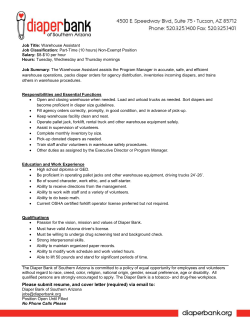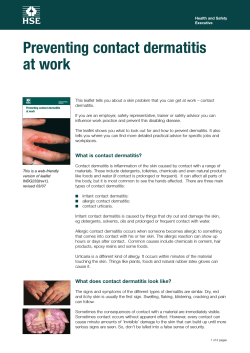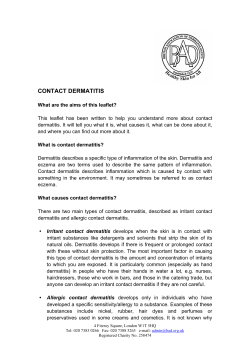
Diaper Dermatitis (Napkin Dermatitis, Nappy Rash) Review
Review Diaper Dermatitis (Napkin Dermatitis, Nappy Rash) Server Serdaroğlu, MD, Tuğba Kevser Üstünbaş, MD Address: Istanbul University Cerrahpaşa Medical Faculty Dermatology Department, Istanbul Turkey E-mail: serverserdaroglu@yahoo.com * Corresponding Author: Server Serdaroğlu, MD, Istanbul University Cerrahpaşa Medical Faculty Dermatology Department, Istanbul Turkey Published: J Turk Acad Dermatol 2010; 4 (4): 04401r. This article is available from: http://www.jtad.org/2010/4/jtad04401r.pdf Key Words: Diaper dermatitis, Napkin dermatitis Abstract Background: The term diaper dermatitis includes all eruptions that occur in the area covered by the diaper. These conditions are caused directly by the wearing of diapers (irritant contact dermatitis), those that are aggrevated by diapers (psoriasis), and those that occur whether or not diapers worn (eg., acrodermatitis enteropathica). Diaper dermatitis is seen mostly between 9- to 12 months. This condition is more common in children but also can be seen in adults using diapers. Many factors play a role on diaper dermatitis etiology. Treatment modality changes according to the severity and etiology of diaper dermatitis. Parents should be informed that refraining from use of diapers improves diaper dermatitis. If diaper dermatitis is persistent, other dermatoses that can localize in genital area should be sought. Introduction The term diaper dermatitis includes all eruptions that occur in the area covered by the diaper. These conditions are caused directly by the wearing of diapers (irritant contact dermatitis), those that are aggrevated by diapers (psoriasis), and those that occur whether or not diapers worn (eg., acrodermatitis enteropathica). In many societies where diapers are not worn, infants escape a condition that is commonly seen in pediatric practice in more industrialized [1]. The first true description of diaper dermatitis was made by Jacquet in 1905 [2]. In 1915, Zahorsky described the frequency of diaper eruptions associated with an “ammoniacal” smelling diaper. In Great Britain in the 1970s, diaper dermatitis accounted for %20 of all skin consultations in the 0- to 5- year age group, and in Japan the prevelance varied between 6 and 50% depending on definitions and inclusion criteria. Diaper dermatitis, considered the most common skin disorder of infancy in the United States, accounts for more than 1 million clinic visits per year [3]. By using the recently developed disposable super-absorbent diapers these proportions reduced significantly. Diaper dermatitis is seen mostly between 9to 12 months. This condition is more common in children but also can be seen in adults using diapers. There is no difference between ethnic groups and gender [4]. Clinically, the type of irritant contact dermatitis mostly seen in genital region, buttocks, upper part of femoral region and lower abdominal area, that becomes because of the reaction between accumulated bacterial enzymes in feces and ammoniac that accumulated in diaper. These appereance also could be seen in olders that have incontinence [5]. Diseases that are most commonly seen in diaper area are listed in Table 1. Page 1 of 4 (page number not for citation purposes) J Turk Acad Dermatol 2010; 4 (4): 04401r. Table 1. Causes of Diaper Dermatitis 1. 2. 3. 4. 5. 6. 7. 8. 9. 10. 11. 12. Chafing, irritant (ammoniacal) dermatitis Candidiasis Psoriasiform dermatitis with id Nutritional abnormalities Granuloma gluteale infantum Letterer-Siwe disease Bullous impetigo Erosive perianal eruption Seborrheic dermatitis Zinc deficiency Cystic fibrosis Kawasaki’s disease Etiology Many factors play a role on diaper dermatitis etiology. 1) Wetness and Friction: The most important factor is wetness of the diaper area. Due to wetness, barrier function of the skin is destroyed and penetration of irritants becomes easier [4]. 2) Urine and feces: Due to the role of fecal enzymes (proteases, lipases) which degrade urea to ammonia, pH increases and skin irritation occurs [1,6]. 3) Microorganisms: Candida albicans may be isolated in up to 80% of infants with perineal skin irritation. Infection occurs generally 4872 hours after irritation [4]. Conditions that are known to increase the likelihood of secondary yeast infection include antibiotic administration, immunodeficiencies, and diabetes mellitus. Bacteria such as Staphylococcus aureus or group A streptococci can cause eruptions in the diaper area. S. aureus colonization is more likely in children with atopic dermatitis. Other bacteria that can lead to inflammation of the vagina and surrounding tissues (vulvovaginitis) include Shigella, Escherichia coli, and Yersinia enterocolitica [1]. Additional infectious agents that can lead to irritation,inflammation or eruptions in the diaper area include viruses (coxsackie, herpes simplex, human immunodeficiency viruses), parasites (pinworms, scabies), and other fungi (tinea) [1]. 4) Nutritional factors: Diaper dermatitis can be the first sign of diet lacking in biotin and zinc [4]. 5) Chemical irritants: Soaps, detergents and antiseptics can trigger or increase primary irritant contact dermatitis. By using disposable diapers this possibility is reduced [4]. http://www.jtad.org/2010/4/jtad04401r.pdf 6) Antibiotics: The use of broad-spectrum antibiotics in infants for conditions such as otitis media and respiratory tract infections has been shown to lead to an increased incidence of irritant napkin dermatitis. This appears to parallel increased recovery of C.albicans from the rectum and skin in such infants [7]. 7) Diarrhoea: The production of frequent liquid faeces is associated with shortened transit times, and such faeces are therefore likely to contain greater amounts of residual digestive enzymes [7]. 8) Developmental abnormalities of the urinary tract: Those anomalies that result in constant passage of urine will predispose to urinary tract infections [7]. Clinical Features Irritant contact dermatitis begins as acute erythema on the convex skin surfaces of the pubic area and buttocks with sparing of the skin folds, reflecting the areas of the body in most contact with the diaper. It’s seen mostly between 3-12 weeks. It may be difficult to clinically differentiate allergic contact dermatitis from irritant contact dermatitis. S aureus infection presents as bullous impetigo, characterized by scattered vesicles, bullae and denuded areas of skin, while group A streptococcus presents as an erythematous patch perianally. The enteric bacteria can cause dysuria, vaginal itching, and vulvar inflammation. Coxsackie virus causes erythematous papules on the buttocks, palms and soles and ulcers in the posterior pharynx. Crops of painful vesicles in the vulva and perianal area characterize herpes. Pruritus is a typical symptom of pinworms and scabies. The appearance of scabies infestation can be variable and should be considered when a child has a diffuse papular eruption that can also affect the head and neck in infants. The characteristic curvilinear lesions of scabies may not be easily identifiable [3]. Jacquet erozive dermatitis; this is the most severe form of diaper dermatitis and can occur at any age [8]. This condition can occur due to diarrhoea [4]. It is characterised by erozive erythematous nodules, well-demarcated, punched out ulcers or erosions with elevated borders [4, 8]. It is seen less commonly Page 2 of 4 (page number not for citation purposes) J Turk Acad Dermatol 2010; 4 (4): 04401r. since the advent of superabsorbent diapers [8]. Granuloma gluteale infantum is a granulomatous reaction that occurs due to irritation, maceration and possible superinfection. This granulomatous reaction is thought to be aggravated by the use of potent topical corticosteroids. This uncommon condition is characterized by reddish purplish papulonodular lesions. On histological examination mixed infiltration (neutrophils, plasma cells, lymphocytes, eosinophils) is seen [4]. Miliaria rubra tends to occur at sites where plastic components of diaper cause occlusion of eccrine ducts of skin [8]. Pseudoverrucous papules and nodules occur in the diaper and perianal areas in patients of any age who have a predisposition to prolonged wetness. Children who wear diapers due to chronic urinary incontinence are prone to this type of dermatitis [8,9]. Granuloma gluteale infantum is important in the differential diagnosis [9]. Histopathology Histopathological findings change according to the clinical features and may include acute, subacute or chronic spongitic dermatitis, mild or moderate inflammatory infiltration in the dermis [4]. Evaluation Patient history and clinical findings are important. Biopsy is rarely necessary [4]. http://www.jtad.org/2010/4/jtad04401r.pdf Table 2. Differantial Diagnosis of Diaper Dermatitis • • • • • • • • • • • Seborrhea Psoriasis vulgaris Moniliasis Intertrigo Allergic contact dermatitis Atopic dermatit Acrodermatitis enteropatica Pyoderma Perianal dermatitis Biotin deficiency Histiyosis X Differential Diagnosis For the list of differential diagnosis of diaper dermatitis see Table 2. In psoriasis vulgaris there is well-demarked erythematous plaques, because of wetness white scarring might not be seen. If eruptions affect the inguinal area or satellite pustules occur and continue longer than 72 hours candidiasis should be suspected [4]. When bacterial infection is superimposed, superficial erosions, yellow crusts and impetiginization is seen [4]. Seborrheic dermatitis is characterized by yellow desquamation on an erythematous background. Hair, face and intertriginous areas may be affected. Atopic dermatitis can cause general eruption on face and body surface and is rarely seen in infants younger than 6 months. Acrodermatitis enteropathica is an autosomal ressesive disease and is seen especially in infants not breastfeeding. Dermatitis, diarrhoea and alopecia is the clasical triad [4]. Table 3. Differantial Diagnosis of Diaper Dermatitis •Use super-absorbent disposable diapers Treatment •Keep the diaper area dry via frequent diaper changes or inspection for soiling at least every 2 hours and even more frequently in children with diarrhea and newborns. Treatment modality changes according to the severity and etiology of diaper dermatitis. Duration of disease, types of treatment, response to treatment should be learned. •To eliminate the irritants at each diaper change, cleanse the diaper area with water plus cotton cloth or commercial “baby wipes” that have minimal additives; avoid excess friction and detergents Prevention of diaper dermatitis is shown in Table 3, treatment of diaper dermatitis is shown in Table 4. •If prone to develop diaper rash, empirically apply a topical barrier that contains water impermeable ingredient (such as zinc oxide) and minimal other ingredients. •Allow for daily diaper-free time and avoid the use of plastic underpants that fit over the diaper area. Candidiasis is the most common reason of diaper dermatitis in adults. First treatment is topical antifungals and protection [4]. Parents should be informed that refraining from use of diapers improves diaper dermatitis. If diaper dermatitis is persistent, other Page 3 of 4 (page number not for citation purposes) J Turk Acad Dermatol 2010; 4 (4): 04401r. dermatoses that can localize in genital area should be sought [4]. Table 4. Treatment of Diaper Dermatitis Step-up the Prevention Measures • Reinforce good diapering hygiene practices at first sign of skin breakdown Apply a Mechanical Barrier • Choose a barrier with minimal ingredients to avoid potential irritants or sensitizers • Use a paste if diarrhea is occurring Prescribe a Topical Antifungal • If rash persists > 3 days • Treat breast-feeding mother if infected and cleanse associated objects • Oral nystatin is reasonable adjunct if thrush is present; other uses of oral antifungals in the routine treatment of diaper dermatitis is not supported in the literature • Never use antifungal-corticosteroid combination products in the diaper area Prescribe a Topical Corticosteroid Judiciously • Apply smallest quantity needed twice daily for 3 days and no longer than 2 weeks of the lowest potency medications; only use in moderate to severe case for symptom relief • Warn parents of serious side effects: adrenal suppression, Cushing syndrome, skin atrophy, and striae Consider Other Interventions • Antibiotics: Topical mupirocin is a reasonable addition if rash progresses or fails to improve despite above measures; oral antibiotics may be necessary in atopic child • Referral to specialist: Consider after 4 weeks of failed treatment or sooner if worrisome signs and symptoms are present. http://www.jtad.org/2010/4/jtad04401r.pdf References 1. Krafchik BR, Halbert A, Yamamoto K, Sasaki R. Eczamatous dermatitis. In: Pediatric Dermatology. Eds. Schachner LA, Hansen RC. 3th Ed. Philadelphia, Mosby, 2003; 630- 632. 2. Langoen A, Vik H, Nyfors A. Diaper dermatitis. Classification, occurrence, causes, prevention and treatment. Tidsskr Nor Laegeforen 1993; 1712-1715. PMID: 8322298 3. Nield LS, Kamat D. Prevention, diagnosis, and management of diaper dermatitis. Clin Pediatr 2007; 46: 480- 486. PMID: 17579099 4. Birol A. Diaper dermatiti. In: Dermatoloji. Eds. Tüzün Y, Gürer MA, Serdaroğlu S, Oğuz O, Aksungur VL. 3 th Ed. İstanbul, Nobel Tıp Kitabevi, 2008; 234 -236. 5. Baykal C. Dermatoloji Atlası. 2 nd Ed. İstanbul, İstanbul Yayınevi, 2004, 252. 6. Berg RW, Buckingham KW, Stewart RL. Etiologic factors in diaper dermatitis: the role of urine. Pediatr Dermatol 1986;102-106. PMID: 3952026 7. Atherton DJ, Gennery AR, Cant AJ. The neonate. In: Rook’s Textbook of Dermatology. Eds. Burns T, Breathnach S, Cox N, Griffiths C. 7 th Ed. Oxford, Blackwell, 2004; 1423 -1427. 8. Chang MW, Orlow SJ. Neonatal, Pediatric and Adolescent Dermatology. In: Fitzpatrick’s Dermatology in General Medicine. Eds. Freedberg IM, Eisen AZ, Wolff K, Austen KF, Goldsmith LA, Katz SI. 6 th Ed. New York, The McGraw-Hill, 2003; 1373 -1374. 9. Sobore JO, Elewski BE. Fungal diseases, granuloma gluteale infantum. In: Dermatology. Eds. Bolognia JL, Jorizzo JL, Rapini RP, Horn TD, Mascaro JM, Mancini AJ, Salasche ST, Saurat JH, Stingl G. 1 st Ed. Philadelphia, Mosby, 2003;1171 -1198. Page 4 of 4 (page number not for citation purposes)
© Copyright 2025









